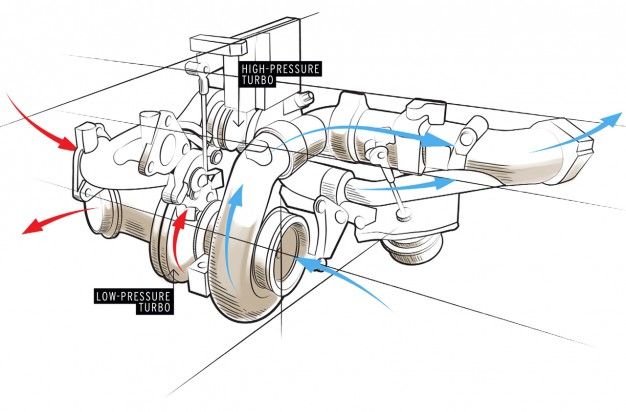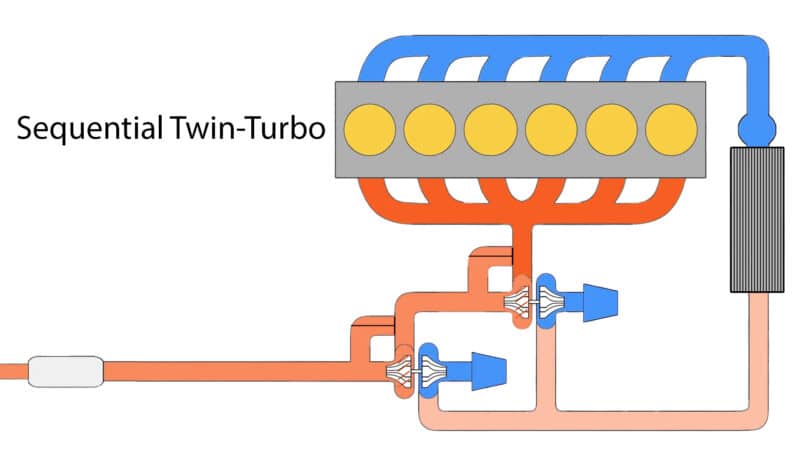

Two years later, at the 1983 Frankfurt Motor Show, Porsche took the covers off its spectacular Gruppe B concept car and announced its intention to compete on the world rally stage, with tobacco company, Rothmans, serving as main sponsor. It was deemed to be the perfect showcase and proving ground for Porsche’s most ambitious project yet, an extreme evolution of the 911. Where Group A cars were largely based on mass-produced models, there was huge freedom in Group B, with no cap on turbo boost or technology. Group B, introduced in 1982 by the FIA, was designed to be a replacement for Group 4 and Group 5. A test mule was constructed to prove the concept of all-wheel drive, and the green light was given to develop a car that could compete in Group B racing.
Sequential turbos full#
Bott got the go ahead from Schutz not only to put his design for a 911 Cabriolet (the first full Porsche drop-top since the demise of the 356) into production, but also to explore the powertrain ideas in the Cabriolet concept further. Group B racing, sequential turbocharging and the Porsche 959Īfter the show, things were perceived to have gone quiet as far as the technology previewed in Frankfurt was concerned, but behind the scenes work began on something rather more magnificent.
Sequential turbos plus#
In truth, it wasn’t a very sophisticated setup, borrowing a driveshaft from the 924 to bring drive to the front axle, plus a differential from the 924 Turbo to apportion power between the front wheels, but behind the system’s existence was the influence of Manfred Bantle, an accomplished engineer, who also worked on the design and development of the 928’s clever Weissach rear axle. The resulting design study was displayed in public at the 1981 Frankfurt Motor Show and made use of a turbocharged 930 engine and a then new four-wheel-drive system. Helmuth Bott, an engineering whizz and Porsche’s director of research and development, had already started planning the first open-topped version of the 911 (a prototype Cabriolet) before Fuhrmann’s departure. His intention? To develop the 911 further, indefinitely. Anecdotally, many of his colleagues were less than happy about this proposal, which came to nought when Fuhrmann was replaced by Peter Schutz in 1981. Ernst Fuhrmann (Chairman of the Board for eight years until 1980) was thought to be planning to discontinue the 911, along with its air-cooled boxer engines, in favour of the front-engined, water-cooled transaxle family of Porsche models.

This was remarkably close to being the end of the 911 story. This sat under the now famous ‘whale tail’ rear spoiler and cooled combustion air after it was compressed by the turbo, enabling output to be raised to a mighty-for-the-time 296bhp and 304lb-ft torque. Porsche increased the capacity of the turbocharged engine to 3.3 litres for 1978, but perhaps of more significance to the success of the 930 was the introduction of an air-to-air intercooler. Its three-litre, air-cooled flat-six used a single turbocharger and initially produced 256bhp and 243lb ft torque against a maximum of 207bhp for the 911 range’s naturally aspirated 2.7-litre boxer. Revealed to the public at the 1974 Paris Motor Show, the 930 went on sale in time for the 1975 model year.


The 930 was, in fact, conceived only to homologate the 935 race car, but despite its flaws (and price), the roadgoing boosted Porsche proved popular, becoming a mainstay of the company’s product line. Here’s how it worksĪlthough turbocharged cars from other manufacturers preceded the 930 (911 Turbo), Porsche’s introduction of forced induction to its flagship model in 1974 is seen as a notable milestone for the automotive industry, not least because engineers in Stuttgart were dedicated to developing and refining the technology in an evolutionary process continuing today. Sequential turbocharging was introduced with the Porsche 959 and has since influenced countless other Porsche products.


 0 kommentar(er)
0 kommentar(er)
